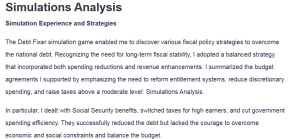Simulations Analysis
Simulation Experience and Strategies
The Debt Fixer simulation game enabled me to discover various fiscal policy strategies to overcome the national debt. Recognizing the need for long-term fiscal stability, I adopted a balanced strategy that incorporated both spending reductions and revenue enhancements. I summarized the budget agreements I supported by emphasizing the need to reform entitlement systems, reduce discretionary spending, and raise taxes above a moderate level: Simulations Analysis.
In particular, I dealt with Social Security benefits, switched taxes for high earners, and cut government spending efficiency. They successfully reduced the debt but lacked the courage to overcome economic and social constraints and balance the budget.
Is High National Debt a Problem for Future Growth?
Yes, a large national debt can limit to a high degree how well the economy can prosper in the future. Higher interest rates for excessive debt mean private investment and productivity growth slow down. Additionally, the debt would force future generations to pay high taxes in order to pay it off, which would make them fear that economic growth might be inhibited.
Consistently, while the ideal form of debt-to-GDP ratio depends on a country’s financial status, the IMF recommends that developed economies keep it below 60% (IMF, 2023). The U.S. has a debt-to-GDP ratio of over 120 percent, rising too high in the long term as of 2024.
The Crowding-Out Effect
The crowding-out effect occurs when increased government borrowing increases interest rates and private-sector investment. Backed with limited funds, the government competes with businesses to raise money from the financial markets, slowing economic growth (IMF, 2023). This is a negative effect because it curtails innovation and job creation in the private sector, consequently reducing total economic performance.
Reference
International Monetary Fund (IMF). (2023). Debt Sustainability Analysis: An Overview of Methodology and Implications for Fiscal Policy. https://www.imf.org
ORDER A PLAGIARISM-FREE PAPER HERE
We’ll write everything from scratch
Question 
6-2 Simulation Discussion: Fiscal Policy
Fiscal policies are used by the government to stabilize the economy. During the 2020 emergency caused by the coronavirus pandemic, the U.S. government approved stimulus spending. According to the U.S. Department of Treasury, the federal government spent 91% more than it collected in revenue, creating a $3.1 trillion deficit. The federal debt grew from $26.9 trillion in 2020 to $34.59 trillion in March of 2024.
For this discussion, first play the simulation The Debt Fixer (from the Committee for a Responsible Federal Budget), in which you make fiscal policy decisions in an attempt to reduce the U.S. debt. You can play the simulation as many times as you like.

Simulations Analysis
In your initial post, include the image (screenshot) of your simulation report in your response. (See the Module Six Simulation Discussion Screenshot Instructions for guidance.) Then, address the following questions:
- Share your experience in the simulation. What strategies did you pursue? Were you successful in reducing the debt?
- In your opinion, is a high national debt a problem for future economic growth? What is the ideal debt-to-GDP ratio? Research academic sources or refer to the information available through the simulation to support your opinion.
- Government spending increases national debt and can cause a crowding-out effect. Explain what the crowding-out effect is and why it’s considered a negative effect of increased government spending.
Textbook:
